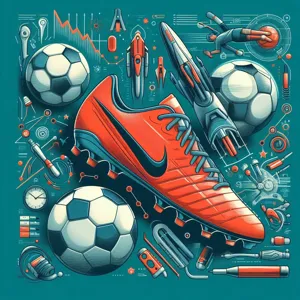When it comes to elevating your football performance, the right pair of shoes can make all the difference.
Whether you’re an aspiring athlete hitting the pitch for the first time or a seasoned player looking to refine your skills, selecting the ideal football shoes is crucial for maximizing comfort, grip, and agility. With a multitude of options available— from cleats designed for firm ground to turf shoes that offer superior stability—understanding the features that matter most can be overwhelming. In this ultimate guide, we will delve into the essential factors to consider when choosing football shoes, explore the latest innovations in footwear technology, and highlight the top brands that cater to every style of play. Get ready to step up your game and enhance your performance on the field with the perfect pair of football shoes!
1. Introduction: The Importance of Football Shoes

When it comes to football, the right shoes can make all the difference between a good performance and a great one. Football shoes, specifically designed to cater to the unique dynamics of the game, play an essential role in enhancing your agility, speed, and overall gameplay. The right pair provides the crucial grip needed to pivot, sprint, and maneuver with confidence, allowing players to focus on their skills rather than worrying about slipping or losing balance.
The importance of football shoes extends beyond mere aesthetics; they are engineered with specific technologies and materials that cater to the demands of the sport. Whether you’re playing on grass, turf, or indoor surfaces, selecting the appropriate footwear can significantly impact your ability to execute precise movements and maintain optimal control of the ball. Additionally, football shoes are designed to provide the right support and cushioning, which can help prevent injuries during those intense, high-stakes matches.
In this guide, we will delve into why investing in quality football shoes is crucial for players of all levels—from seasoned professionals to enthusiastic beginners. By understanding the unique features and functionalities of different types of football shoes, you’ll be better equipped to make an informed choice that not only enhances your performance but also boosts your confidence on the field. Whether you’re aiming for that game-winning goal or simply looking to improve your skills, the right pair of football shoes is your first step towards success.
2. Types of Football Shoes: Cleats, Turf, and Indoor Options
When it comes to football shoes, understanding the different types available can significantly enhance your performance on the field. Each category of shoe is designed with specific playing surfaces in mind, ensuring that you have the right traction, support, and comfort for your style of play. Let’s dive into the three main types: cleats, turf shoes, and indoor options.
**Cleats** are the go-to choice for traditional outdoor football. These shoes feature blades or studs on the outsole, which dig into the grass or soft ground, providing the grip needed for explosive sprints, sharp cuts, and sudden stops. Cleats are available in various designs tailored for specific conditions—firm ground (FG) for dry, natural grass fields, soft ground (SG) for muddy pitches, and artificial ground (AG) for synthetic turf. Understanding the right type of cleat for the conditions you’ll face can significantly affect your stability and speed during a game.
**Turf shoes**, on the other hand, are ideal for playing on artificial surfaces or well-maintained grass fields. They come with a rubber outsole that features short, multi-directional studs, offering superior traction without the risk of getting stuck in the turf. Turf shoes are designed to provide comfort and support during longer training sessions or games, making them a versatile option for players who spend a lot of time on synthetic surfaces. They also tend to have a more cushioned feel, which can help in reducing fatigue during play.
Lastly, there are **indoor football shoes**, which are essential for those who play in gyms or indoor arenas. These shoes typically feature a flat, non-marking rubber sole that provides excellent grip on smooth surfaces without the risk of damaging the flooring. The lightweight design and breathable materials help enhance agility and speed, allowing for quick movements and changes of direction typical in indoor football. When choosing indoor shoes, look for models that offer good ankle support and cushioning to keep you comfortable during fast-paced play.
By selecting the right type of football shoe based on the surface you’ll be playing on, you can ensure that you are maximizing your potential on the field. The right footwear not only enhances your gameplay but also helps to reduce the risk of injuries, allowing you to focus on what you do best: playing the game.
3. Understanding Different Playing Surfaces: Grass, Turf, and Indoor

When it comes to selecting the perfect football shoes, understanding the playing surface is paramount. Each environment—grass, turf, and indoor—offers unique challenges and requires specific footwear characteristics to enhance performance and ensure safety.
**Grass**: Traditional grass pitches are often favored for their natural feel and traction. For these surfaces, cleats with longer, molded studs are ideal. They provide the grip necessary for quick turns and explosive acceleration on soft ground. However, the condition of the grass can vary; a wet, muddy pitch demands shoes designed for optimal drainage and stability, while a dry, firm pitch requires cleats that can dig in without slipping. Look for shoes with customizable stud patterns that cater to the specific conditions you’ll encounter.
**Turf**: As synthetic surfaces become increasingly common, the need for specialized turf shoes grows. Unlike grass cleats, turf shoes feature shorter, rubber studs that are designed to offer maximum traction without damaging the playing surface. They allow for quick lateral movements and are great for preventing injuries during intense play. If you frequently play on turf, opt for shoes that provide adequate support and cushioning to absorb the impact of the harder ground while allowing for swift footwork.
**Indoor**: For indoor football, a different approach is necessary. Indoor shoes typically have a flat, rubber sole that provides excellent grip on smooth surfaces, allowing for quick pivots and agile movements. These shoes are designed to enhance ball control and precision, critical for the fast-paced nature of indoor play. When selecting indoor footwear, look for a lightweight design that promotes agility while ensuring your feet are well-supported during those rapid shifts in direction.
By understanding the nuances of each playing surface, you can choose football shoes that not only fit your style of play but also significantly enhance your overall performance on the field. The right pair will provide the traction, comfort, and support necessary to elevate your game, allowing you to focus on what you do best: playing football.
4. Key Features to Look for in Football Shoes
When it comes to choosing the ideal football shoes, understanding the key features that enhance your performance on the pitch is essential. The right pair can make a significant difference in your agility, comfort, and overall gameplay. Here are the crucial elements to consider:
**1. Fit and Comfort:** The foundation of any great football shoe begins with a proper fit. Look for shoes that hug your foot snugly without being overly tight. A comfortable shoe allows for better control and reduces the risk of blisters during intense matches. Consider trying on multiple sizes and styles to find the perfect fit for your foot shape.
**2. Traction:** The sole of your football shoes plays a pivotal role in your ability to make sharp turns, sudden stops, and quick sprints. Depending on the surface you’ll be playing on—be it firm ground, artificial turf, or soft ground—choose shoes with the appropriate stud configuration. Cleats with a mix of conical and bladed studs can provide the right balance of grip and maneuverability.
**3. Material:** The upper material of your football shoes can greatly affect your comfort and touch on the ball. Leather offers durability and a classic feel, while synthetic materials are lightweight and often water-resistant. Some modern shoes blend both materials to provide the best of both worlds. Look for a shoe that offers a good balance between breathability and support.
**4. Weight:** In the fast-paced game of football, every ounce matters. Lighter shoes can enhance your speed and agility, allowing you to navigate the field with ease. However, be cautious not to sacrifice essential features like support and durability for weight. Find a pair that feels light yet still offers the protection you need.
**5. Ankle Support:** Depending on your playing style, you may benefit from shoes that provide additional ankle support. High-top designs can help stabilize your ankle during quick movements, reducing the risk of injury. However, if you prefer greater freedom of movement, low-cut shoes may be more suitable.
**6. Cushioning:** Football matches can be tough on your feet, especially when sprinting across the pitch. Look for shoes with adequate cushioning to absorb impact and provide comfort during play. Features like EVA foam or gel inserts can enhance shock absorption, ensuring that your feet feel fresh even in the final minutes of the game.
By considering these key features when selecting your football shoes, you’ll not only enhance your performance but also enjoy a more enjoyable and injury-free game. Remember, the right shoes are an investment in your skills and passion for the sport.
5. The Role of Fit: Why Size Matters in Performance

When it comes to football shoes, the importance of a proper fit cannot be overstated. A shoe that fits well can significantly enhance your performance on the pitch, while an ill-fitting pair can lead to discomfort and hinder your game. The right fit ensures that your feet are securely held in place, allowing for optimal agility, stability, and control as you maneuver across the field.
First and foremost, a well-fitted shoe helps prevent blisters and calluses, which are common issues for players who spend hours on their feet. The last thing you want is to be distracted by discomfort or pain while trying to focus on executing that perfect pass or making a critical tackle. Choosing a shoe that accommodates the unique shape of your feet—whether you have wide, narrow, or high-arched feet—can make all the difference in your comfort level.
Moreover, a properly fitted football shoe enhances your overall balance and support. When your shoes hug your feet snugly, you gain a better sense of connection to the ground, leading to improved traction and stability. This is especially crucial during rapid movements like sprinting, cutting, and stopping. A shoe that is too loose can cause your foot to slide around inside, increasing the risk of injuries such as ankle sprains.
To find the perfect fit, it’s essential to try on shoes at the end of the day when your feet are slightly swollen from regular activities. Make sure there is enough space (about a thumb’s width) at the front of the shoe for your toes to move freely but not so much that your foot feels unstable. Remember to wear the same type of socks that you would use during a game to get an accurate feel.
Ultimately, investing the time to find the right fit will not only enhance your comfort on the field but also elevate your game performance. When your shoes fit perfectly, you can focus on what truly matters: playing the beautiful game to the best of your ability.
6. Material Matters: Leather vs. Synthetic
When it comes to football shoes, the material they’re made from can significantly impact your performance on the field. The two primary contenders in this arena are leather and synthetic materials, each boasting its own set of advantages and disadvantages that cater to different playing styles and environmental conditions.
**Leather football shoes** have long been favored by players for their natural feel and breathability. The premium quality of leather molds to the shape of your foot over time, creating a personalized fit that enhances comfort and stability. This adaptability allows for better ball control, giving you that coveted touch when dribbling or passing. Additionally, leather shoes often provide superior durability, standing up to the wear and tear of rigorous play. However, it’s worth noting that leather can be heavier and may require a break-in period, which might not suit every player’s immediate needs.
On the other hand, **synthetic football shoes** have surged in popularity, particularly among those who prioritize lightweight performance and water resistance. These shoes are designed to be lightweight, allowing for quicker foot movement and agility on the pitch. Their smooth surfaces often provide a consistent strike on the ball, enhancing shooting accuracy. Moreover, synthetic materials are typically easier to clean and maintain, making them a practical choice for players who frequently train in inclement weather. However, they may lack the same level of breathability as leather, which can lead to discomfort during extended play.
Ultimately, the choice between leather and synthetic comes down to personal preference and playing style. Whether you crave the classic touch of leather or the modern efficiency of synthetic materials, understanding the differences can help you make an informed decision. Remember, the right pair of football shoes is not just about style; it’s about enhancing your game performance and elevating your skills on the field.
7. Stud Configuration: Choosing the Right Traction

When it comes to football shoes, the stud configuration plays a pivotal role in determining your on-pitch performance. The right traction can mean the difference between a clean breakaway and a slippery stumble, so it’s essential to understand the various options available and how they can enhance your game.
Studs come in different shapes, sizes, and arrangements, each designed for specific field conditions and playing styles. For instance, conical studs, which taper to a point, provide excellent grip and allow for quick pivots and turns on firm ground. These are ideal for dry, natural grass pitches, allowing players the agility they need to navigate tight spaces and evade defenders.
On the other hand, bladed studs, which are longer and have a rectangular shape, offer superior traction and stability, making them ideal for softer ground. They dig into the turf, helping players maintain balance during high-intensity movements. If you often play on muddy or wet fields, shoes with this type of stud configuration can provide the extra grip you need to stay upright and perform at your best.
For those who frequently switch between different playing surfaces, consider multi-ground studs that can adapt to both firm and soft conditions. These versatile options feature a hybrid configuration, allowing for optimal performance whether you’re on a grass pitch or an artificial surface.
When selecting your football shoes, consider not only the type of stud but also the spacing between them. A wider stud configuration can provide stability, while closer stud arrangements can enhance agility. Additionally, the material of the studs—whether molded or detachable—can impact durability and performance, allowing you to tailor your footwear to your specific needs.
Ultimately, the right stud configuration is about finding the perfect balance between traction and comfort. By matching your shoes to your playing style and the conditions of the pitch, you can enhance your game performance and feel confident in every stride. Make sure to do your research, try on different styles, and assess how each option feels as you move, ensuring that your footwear becomes a trusted ally on the field.
8. Cushioning and Support: Protecting Your Feet
When it comes to football shoes, cushioning and support are not just luxury features; they are essential components that can significantly influence your performance on the field. The right amount of cushioning absorbs the impact from running and jumping, reducing the risk of injuries and ensuring that you can play at your best for the full duration of the match.
Modern football shoes often incorporate advanced cushioning technologies, such as responsive foam or gel inserts, designed to provide a comfortable and protective barrier between your feet and the hard ground. These innovations allow for better shock absorption, helping to minimize fatigue and discomfort as the game progresses. Players can choose from varying levels of cushioning, allowing for a personalized fit that aligns with their playing style—whether you prefer a more cushioned feel for comfort or a firmer sole for better ground connection.
Support is equally critical, especially for those making quick cuts and sharp turns on the field. Look for shoes that provide adequate ankle support and stability, which can prevent sprains and other common injuries. Brands often design football shoes with additional features like reinforced heel counters and midsole structures that help keep your foot secure in the shoe, promoting a more controlled movement.
Additionally, consider the shape and fit of the shoe. A well-fitted shoe should hug your foot without being too tight, ensuring that you have the right balance of support and freedom of movement. When your feet feel good, you’re more likely to focus on your game, making strategic plays and executing techniques without the distraction of discomfort.
In summary, investing in football shoes with the right cushioning and support not only protects your feet but also enhances your overall game performance. By prioritizing these features, you’re setting yourself up for success on the pitch, allowing you to play harder, longer, and with greater confidence.
9. Brand Comparisons: Top Football Shoe Brands Reviewed
When it comes to selecting the perfect football shoes, the brand can often play a crucial role in the performance, comfort, and durability of the footwear. In this section, we’ll dive into a comparative review of the top football shoe brands, highlighting their unique features, technologies, and what sets them apart from one another.
**Nike:** Known for its innovative designs and cutting-edge technology, Nike football shoes are a favorite among many professional players. The Nike Mercurial line, for instance, is celebrated for its lightweight construction and explosive speed, making it ideal for forwards looking to outpace their opponents. The brand’s Flyknit technology provides a snug fit, ensuring maximum comfort and responsiveness on the pitch.
**Adidas:** With a legacy steeped in football history, Adidas offers a diverse range of footwear catering to all playing styles. The Predator series, for instance, is renowned for its grip and control, making it perfect for midfielders who dictate the game’s pace. Adidas also incorporates Boost technology in some models, offering unmatched energy return and cushioning for enhanced performance during those high-stakes matches.
**Puma:** Puma has carved a niche for itself by blending style with functionality. The Puma Future series is particularly noted for its adaptive fit and agility, allowing players to make quick cuts and movements with ease. Their collaboration with professional athletes ensures that their designs are not just aesthetically pleasing but also performance-driven.
**New Balance:** Though relatively newer in the football scene, New Balance has quickly gained traction among players. Their Furon and Tekela ranges focus on precision and speed, making them ideal for players who thrive on quick footwork and agility. With a commitment to comfort, New Balance shoes often feature wider toe boxes, catering to players seeking additional space without compromising on performance.
**Mizuno:** For those looking for craftsmanship and attention to detail, Mizuno stands out. Their football shoes are often handcrafted, providing a level of quality that is hard to match. The Mizuno Morelia line is a favorite for its classic design and superior touch, making it a great choice for players who value ball control and finesse.
In conclusion, understanding the strengths and specialties of each brand can significantly impact your choice of football shoes. Whether you prioritize speed, control, comfort, or aesthetics, there’s a perfect pair out there tailored to enhance your game performance. As you consider your options, think about your playing style and personal preferences—after all, the right football shoes can be a game-changer on the pitch.
10. Price vs. Performance: Finding the Right Balance
When it comes to football shoes, the age-old debate of price versus performance often looms large in the minds of players. It’s tempting to gravitate toward cheaper options, especially for those just starting out or for casual players. However, skimping on quality can often lead to discomfort, poor traction, and even injuries on the field. Conversely, splurging on high-end models doesn’t always guarantee an immediate boost in performance.
Finding the right balance between price and performance requires careful consideration of several factors. First, assess your playing style and frequency of play. If you’re a dedicated player who spends several hours a week on the pitch, investing in a pair of mid to high-end shoes that offer superior grip, support, and durability can significantly enhance your game. Features like lightweight materials, cushioned soles, and specialized traction patterns can all contribute to improved agility and speed, giving you an edge over your opponents.
On the other hand, for those who play occasionally or at a recreational level, there are plenty of mid-range options that provide excellent performance without breaking the bank. Look for shoes that offer a good fit and comfort, as these are crucial for optimal performance. Many brands have options that combine affordability with advanced technology, ensuring you don’t sacrifice too much on performance while keeping your budget in check.
It’s also wise to keep an eye out for seasonal sales or discounts which can make higher-end shoes more accessible. Remember, investing in quality footwear is not just about the initial price; it’s about the long-term benefits it brings to your game. A well-chosen pair of football shoes can lead to better ball control, increased speed, and a more enjoyable playing experience overall. In the end, the right pair can make all the difference—helping you stay injury-free while elevating your performance on the field.
11. Tips for Breaking in New Football Shoes
Breaking in a new pair of football shoes can often feel like a rite of passage for players, and doing it correctly is crucial to ensuring comfort and performance on the field. Here are some effective tips to help you ease into your new kicks without the pain that often accompanies a fresh pair.
First, start with shorter training sessions. Instead of jumping straight into a full match, wear your new shoes during light practice sessions or even casual jogs. This gradual exposure allows the materials to soften and adapt to the contours of your feet without overwhelming discomfort. Aim for 20 to 30 minutes at a time, gradually increasing the duration as your feet acclimate.
Next, consider wearing thick socks to help stretch the material. While this may feel a bit snug initially, thicker socks can help reduce friction and provide a cushioning layer that prevents blisters. As the shoes stretch over time, you can switch back to your regular socks for a better fit.
Another effective method is to use a shoe stretcher or specific stretching spray designed for athletic footwear. These tools can help expand the shoe fabric gently, allowing for a more customized fit without the risk of damaging the shoes. If you choose to go this route, remember to focus on the areas that feel the tightest, ensuring optimal comfort during play.
Additionally, try to walk around your home in the new shoes as much as possible. This simple act can help ease any stiffness in the soles and give you a better feel for how they perform. The more you wear them, the more they will mold to your feet, reducing the risk of injury while enhancing your overall performance.
Lastly, listen to your body. If you experience significant discomfort or pain, don’t hesitate to take a step back and give your feet a break. It’s better to take the time to break in your shoes properly than to push through the pain and risk injury. With patience and these tips in mind, you’ll soon find yourself gliding across the pitch with confidence, ready to take your game to the next level!
12. Maintaining and Caring for Your Football Shoes
### 12. Maintaining and Caring for Your Football Shoes
Your football shoes are more than just gear; they are a crucial investment in your performance on the pitch. Proper maintenance and care can significantly enhance their lifespan, ensuring that you get the most out of every pair. Here are some essential tips to keep your football shoes in top shape.
**1. Clean After Every Game:**
After each match, take a moment to clean your shoes. Remove any mud, grass, or debris using a soft brush or cloth. For stubborn stains, a damp cloth with mild soap can work wonders. Avoid soaking your shoes in water, as excessive moisture can damage the materials and affect the fit.
**2. Dry Properly:**
If your shoes get wet, allow them to dry naturally at room temperature. Stuffing them with newspaper can help absorb moisture and maintain their shape. However, never place them near direct heat sources like radiators or hair dryers, as this can warp or crack the materials.
**3. Store Wisely:**
When not in use, store your shoes in a cool, dry place. A ventilated shoe bag is ideal to protect them from dust while allowing airflow. Avoid leaving them in your car or other enclosed spaces where temperatures can fluctuate dramatically.
**4. Rotate Your Shoes:**
If you play frequently, consider investing in multiple pairs of football shoes. Rotating them not only gives each pair a chance to breathe but also allows you to accommodate different playing conditions, such as firm ground, soft ground, or turf.
**5. Check for Wear and Tear:**
Regularly inspect your shoes for signs of wear, such as worn-out studs or frayed laces. Address any issues promptly to prevent further damage and maintain optimal performance. Replacing worn studs can improve traction and stability during play.
**6. Use the Right Products:**
Consider applying specialized waterproofing sprays or conditioners designed for football shoes. These products can help protect against stains and moisture, especially in harsher weather conditions. Just ensure they are compatible with the shoe materials.
By investing time in maintaining and caring for your football shoes, you not only extend their lifespan but also ensure that they continue to perform at their best. Remember, a well-cared-for pair of shoes can make all the difference in your game, providing the support and traction you need to elevate your performance on the field.
13. How to Choose the Right Shoes for Your Position
Choosing the right football shoes for your position on the field can significantly enhance your performance and overall game experience. Each position has unique demands, and the right footwear can provide the necessary support, traction, and comfort to help you excel.
**1. For Forwards and Attacking Players:**
If you’re a forward or an attacking player, you need shoes that offer agility and speed. Look for lightweight options with a snug fit that allows for quick movements. Cleats with a good toe spring can aid in explosive sprints toward the goal. Brands often design these shoes with a focus on grip, so you can cut and change direction swiftly without losing your footing.
**2. For Midfielders:**
Midfielders play a versatile role and need shoes that balance agility and stability. Opt for cleats that provide cushioning for those long runs and the ability to make quick pivots. A shoe with a wider stud configuration can help maintain balance while providing the traction needed to navigate through tight spaces and engage in tackles.
**3. For Defenders:**
Defenders require shoes that offer durability and support, as they often engage in physical play. Look for cleats that have a robust construction to withstand the rigors of the game. A shoe with a higher ankle design can provide additional support, which is essential for making those challenging tackles while maintaining stability.
**4. For Goalkeepers:**
As a goalkeeper, your footwear should prioritize grip and comfort, as you’ll need to be quick on your feet while also having a solid base for jumping and diving. Choose shoes with excellent traction that allows you to pivot easily when anticipating the ball’s trajectory. Some goalkeepers prefer turf shoes, as they often provide better control and stability on the field.
**5. Consider Playing Surface:**
Finally, it’s crucial to match your shoes to the playing surface. Whether you’re playing on firm ground, artificial turf, or soft ground, each type of cleat is designed specifically for its environment. Firm ground cleats are ideal for natural grass, while turf shoes are engineered for synthetic surfaces. Choosing the appropriate shoe will not only enhance your performance but also reduce the risk of injury.
By understanding the specific requirements of your position and the surfaces you play on, you can make an informed choice that will help elevate your game. Investing in the right pair of football shoes is not just about comfort; it’s about giving yourself the best chance to succeed on the field.
14. Real Player Testimonials: What Works for Them
When it comes to choosing the right football shoes, there’s no better guidance than firsthand accounts from the players who wear them on the field. Real player testimonials offer invaluable insights into the nuances of different footwear options and how they can profoundly impact performance.
Take, for instance, professional midfielder Alex Thompson, who swears by his lightweight cleats that provide superior agility. “I need shoes that allow me to make quick cuts and accelerate without feeling weighed down,” he explains. His choice of footwear is a game-changer, helping him navigate through defenders with ease.
On the other hand, veteran defender Maria Rodriguez emphasizes the importance of stability and traction. “I rely on my shoes to keep me grounded during plays. A good pair with excellent grip lets me focus on my positioning instead of worrying about slipping,” she shares. Her testimonials highlight the critical role that the right shoes play in ensuring safety during intense matches.
Then there’s rising star Jamie Lee, who has recently made waves in the youth leagues. Jamie’s preference for shoes with a cushioned insole reflects his need for comfort during long training sessions. “If my feet hurt, I can’t perform at my best. It’s essential to choose shoes that keep my feet happy, even after hours on the pitch,” he notes.
These testimonials not only shed light on individual preferences but also illuminate the diverse features available in different football shoes. Whether it’s weight, traction, stability, or comfort, hearing from real players helps aspiring athletes make informed decisions tailored to their own playing styles and needs. By drawing on these insights, you can gain a clearer understanding of how the right footwear can elevate your game, making each pass, shot, and sprint more effective. Ultimately, when you lace up the right pair, you’re not just putting on shoes—you’re equipping yourself for success on the field.
15. Conclusion: Elevating Your Game with the Right Footwear
In conclusion, the importance of choosing the right football shoes cannot be overstated. A well-fitting, purpose-driven pair of boots can significantly enhance your performance on the field, allowing you to play with confidence and agility. The right footwear not only provides the necessary traction for quick sprints and sharp turns but also ensures your feet remain comfortable throughout the game, reducing the risk of injuries and fatigue.
As you consider your options, remember to evaluate factors such as fit, style, and the specific playing surface you’ll be on. Each player has unique needs based on their position and playing style, so taking the time to select the ideal pair tailored to you can make all the difference. Whether you’re a seasoned pro or just starting, the right football shoes will empower you to unleash your full potential and elevate your game to new heights.
Ultimately, investing in quality footwear is investing in your passion for the sport. So, lace up your chosen pair, hit the field, and watch as your performance transforms—because when it comes to football, every detail counts, and the right shoes can be the key to unlocking your best game yet.
In conclusion, choosing the right football shoes is an essential step toward elevating your game performance and ensuring an enjoyable playing experience. We’ve explored the various factors to consider, from traction and fit to materials and style, all of which play a critical role in how you perform on the field. By selecting a pair that aligns with your playing style and the conditions you face, you not only enhance your agility and stability but also gain that extra confidence needed to give your best effort. We hope this ultimate guide empowers you to make informed decisions, helping you step onto the field with the right gear that complements your skills and passion for the game. Now, lace up those shoes and get ready to take your performance to new heights!






